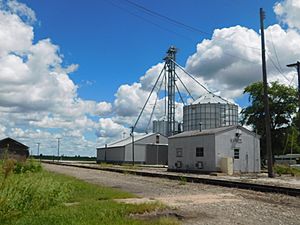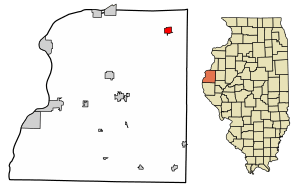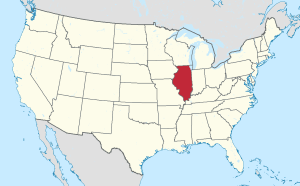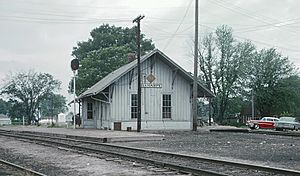La Harpe, Illinois facts for kids
Quick facts for kids
La Harpe, Illinois
|
|
|---|---|

The former Toledo, Peoria and Western Railroad tracks through La Harpe
|
|

Location of La Harpe in Hancock County, Illinois.
|
|

Location of Illinois in the United States
|
|
| Country | United States |
| State | Illinois |
| County | Hancock |
| Area | |
| • Total | 1.36 sq mi (3.53 km2) |
| • Land | 1.36 sq mi (3.53 km2) |
| • Water | 0.00 sq mi (0.00 km2) |
| Population
(2020)
|
|
| • Total | 1,175 |
| • Density | 861.44/sq mi (332.72/km2) |
| Time zone | UTC-6 (CST) |
| • Summer (DST) | UTC-5 (CDT) |
| ZIP Code(s) |
61450
|
| Area code(s) | 217 |
| FIPS code | 17-40832 |
| Wikimedia Commons | La Harpe, Illinois |
La Harpe is a town in Hancock County, Illinois, United States. The population was 1,235 at the 2010 census, down from 1,385 at the 2000 census.
Geography
La Harpe is located at 40°34′59″N 90°58′08″W / 40.582925°N 90.968770°W, along the South Branch La Moine River.
According to the 2010 census, La Harpe has a total area of 1.36 square miles (3.52 km2), all land.
History
During the 18th century, French explorers headed by Bernard de la Harpe were forced to spend the winter just north of the present city of La Harpe, Illinois. About 1896, four stone tablets dated June 15, 1715 and inscribed in French were reportedly found a few miles east of the old fortication built by the explorers. Stones were conveniently translated locally by the only French family in town as follows: "We are surrounded by indians and have no hope for survival unless help soon arrives." Said stone tablets were reported to be sent to the Smithsonian for authentication, and were ruled a hoax. Their whereabouts are currently unknown.
Soon after 1830, landowners in the area began to develop a town which they called Franklin. In 1836, they applied for a post office and were informed another town in Illinois was already named Franklin. The first postmaster, Louis Rice Chaffin, suggested the name be registered as La Harpe, for the Frenchman who spent the winter over 100 years earlier. The City of La Harpe was granted a charter by the Illinois legislature in 1859. The charter was amended in 1861 to change the size of the town, and the boundaries have changed through the years. Today the city has 22 streets and avenues.
In 1867, the TP&W railroad line was completed through the town. In 1888, the City council bought the first fire engine, but a fire in October 1893 still destroyed nearly all the businesses in one block of Main Street. City Hall was built in 1894. The election of 1895 was the first election in which the women of LaHarpe were allowed to vote on the issue of liquor licenses (The women had a separate ballot box). The La Harpe Carnegie Public Library was built in 1905, with local support and a donation from Andrew Carnegie. Today it is listed on the National Register of Historic Sites. The City Park was donated by Marvin Tyron, one of the town's founders, as a public square.
In 1986, La Harpe celebrated 150 years of history. During that year, a Sesquicentennial History entitled La Harpe, Illinois, 1836-1986 was published.
Each summer the town used to host and celebrates during the annual Summerfest on the town square. In addition, the annual Fred Gibb Car Show is held in August. Mr. Gibb's claim to fame was the sponsor of the original ZL-1 COPO Camaros and Novas during the pony car era of the early 1970s. Gibb's name has been omitted from the car show.
Today, many of the surviving buildings in La Harpe's business districts, including the City Hall, are on the National Register of Historic Places. La Harpe had the only 4-story building in Hancock County. The park district includes a community club house, swimming pool, LaMoine Valley golf course and a complex of lighted ball fields. The city park has a lighted shelter house and stage.
Park District
- Lamoine Valley Golf Club
LaHarpe Community Swimming Pool
Demographics
| Historical population | |||
|---|---|---|---|
| Census | Pop. | %± | |
| 1880 | 958 | — | |
| 1890 | 1,113 | 16.2% | |
| 1900 | 1,591 | 42.9% | |
| 1910 | 1,349 | −15.2% | |
| 1920 | 1,323 | −1.9% | |
| 1930 | 1,175 | −11.2% | |
| 1940 | 1,322 | 12.5% | |
| 1950 | 1,295 | −2.0% | |
| 1960 | 1,322 | 2.1% | |
| 1970 | 1,240 | −6.2% | |
| 1980 | 1,471 | 18.6% | |
| 1990 | 1,407 | −4.4% | |
| 2000 | 1,385 | −1.6% | |
| 2010 | 1,235 | −10.8% | |
| 2020 | 1,175 | −4.9% | |
| U.S. Decennial Census | |||
As of the census of 2000, there were 1,385 people, 561 households, and 383 families residing in the city. The population density was 1,021.8 people per square mile (393.2/km2). There were 604 housing units at an average density of 445.6 per square mile (171.5/km2). The racial makeup of the city was 99.78% White, 0.07% from other races, and 0.14% from two or more races. Hispanic or Latino of any race were 0.14% of the population.
There were 561 households, out of which 31.2% had children under the age of 18 living with them, 57.0% were married couples living together, 9.4% had a female householder with no husband present, and 31.6% were non-families. 29.1% of all households were made up of individuals, and 16.0% had someone living alone who was 65 years of age or older. The average household size was 2.39 and the average family size was 2.93.
In the city, the population was spread out, with 24.0% under the age of 18, 6.5% from 18 to 24, 24.4% from 25 to 44, 23.5% from 45 to 64, and 21.7% who were 65 years of age or older. The median age was 41 years. For every 100 females, there were 85.2 males. For every 100 females age 18 and over, there were 77.3 males.
The median income for a household in the city was $32,589, and the median income for a family was $37,708. Males had a median income of $31,250 versus $20,400 for females. The per capita income for the city was $15,586. About 4.6% of families and 7.4% of the population were below the poverty line, including 8.9% of those under age 18 and 6.3% of those age 65 or over.
Notable people
- Harold Arlin, radio's first salaried announcer, born in La Harpe
- Charles Duryea, co-invented first gasoline-powered automobile, graduated from La Harpe's Gittings Seminary (1882)
- Olive Oatman, pioneer Mormon teenager abducted by Native Americans who marked her with a chin tattoo. (1851)
- Olan Soule, actor, born in La Harpe
See also
 In Spanish: La Harpe (Illinois) para niños
In Spanish: La Harpe (Illinois) para niños


